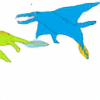HOME | DD
 Harry-the-Fox — Paraceratherium
Harry-the-Fox — Paraceratherium

Published: 2013-12-24 01:10:21 +0000 UTC; Views: 10407; Favourites: 116; Downloads: 85
Redirect to original
Description
Finally back!And I decided to come back with an animal I've wanted to do for ages- the Paraceratherium (better known as the indricotherium for anyone that watched the BBC's "Walking with Beasts").
This work was done by a new technique by collecting photographs of museum displays and also skeletal/anatomical diagrams (in this case of both the paraceratherium and the rhinoceros to double check how the flesh joins on) and drawing the animal over the top to ensure maximum accuracy.
Of course, there are some obstacles- a lot of displays and diagrams arrange the bones slightly differently- and there seems to be a HUGE discrepancy between different reconstructions over how long the neck vertebrae and the overall neck itself actually was- with some suggesting something much shorter (closer to most modern ungulates) and some other lengths very long indeed. I cautiously angled towards the slightly shorter end of the spectrum (though still vastly longer than some have depicted it). These proportions are roughly how most paraceratheriums are depicted.
Related content
Comments: 34

👍: 1 ⏩: 1

👍: 0 ⏩: 0

It's a very impressive animal, more impressive than some sauropods to be honest . By the way, do you intend to do more sauropods? I really like your work
👍: 0 ⏩: 1

Indeed- it stands taller than Apatosaurus- and among the dinosaurs, only the titanosaurs surpassed its height (by quite a lot), and they of course were large, even for a sauropod.
As a matter of fact I DO plan to do more sauropods. I have a few size charts I'm currently working on (of other animals) but sauropods are my next big attempt, as they're fascinating (and have a fairly straightforward anatomy to recreate, especially considering I'm fairly practiced with theropods now).
Admittedly I'll probably do the more well-known ones to begin with, as most other sauropods often are based on incomplete fossils. I especially want another shot at Brachiosaurus or Giraffotitan, along with Apatosaurus.
👍: 0 ⏩: 1

Large brachiosaurs, mamenchisaurs, the largest euhelopodids, titanosaurs and exceptional diplodocoids all surpassed Paraceratherium in height....
👍: 0 ⏩: 1

You appear to be right there actually.
The largest Mamenchisaurus species would indeed dwarf this animal substantially (though it also dwarfs the next largest mamenchisaurus even moreso).
And the others I incorrectly presumed as titanosaurs (due to belonging to the titanosauriformes clade); but yep, I was otherwise aware that both brachiosaurus and giraffititan are vastly larger and taller than paraceratherium.
Supersaurus also surpasses paraceratherium slightly, the very largest diplodocus matches close to its size; and if you count amphicoleas, obviously vastly larger.
👍: 0 ⏩: 1

Wow, that's amazing.
Shame it got dwarfed by some elephant, though.
👍: 0 ⏩: 2

Dwarfed is an exaggeration, but it exceeded the size of Paraceratherium.
👍: 0 ⏩: 1

To be fair, it's a pretty awesome elephant.
And technically speaking, it seems to be a close match- the main factor tipping the scales to Palaeoloxodon Namadicus is the fact that the Paraceratherium is very er, 'gracile' for such a huge animal- while the elephant had an insanely heavy build.
👍: 0 ⏩: 1

Yeah- it's REALLY shocking when we consider that it seemed almost certain that Paraceratherium was massively pushing the boundaries of mammal size, suggesting that such a feat was only possible by stretching out a 'light' body to fantastic proportions (much like the popular Deinotherium did by having elongated legs)...
....and then we get an elephant that reaches the same size, and was simply really big.
👍: 0 ⏩: 1

Good work, though I don't agree with the weigh estimate of 12 tonnes, I think 16-17 tonnes is more likely, since it is a large individual, not an average sized (an average sized 11 tonne Paraceratherium is about 4.2 m tall at the shoulders, while a large is 4.8 m tall at the shoulders).
👍: 0 ⏩: 2

The largest known specimen is about 17 tonnes, though it is fragmentary and was almost certainly a giant. The largest complete ones that were probably the average are in the 8-11 tonne range. So I'd say you're right here
👍: 0 ⏩: 0

That's a VERY good point- and makes sense seeing that a large Paraceratherium is vastly above 2x larger (but probably a bit less than 3x larger) than an African Bush Elephant (which usually weighs up to 5.5 tonnes; though on that note I should double-check if THAT size was for average specimens (usually 3.3m at the shoulder) to very large ones reaching up to 4m).
On a side note, I've actually been planning to do an update on this image soon (much better detail among other things- the image is mostly complete); I'm mainly just doing the research behind it- and I'll be sure to double check the weights next time as well.
👍: 0 ⏩: 1

Ok. I just want to make clear that 16-17 tonnes is based on that two source: Gregory S. Paul (1992). "The size and bulk of extinct giant land herbivores" (PDF). and Larramendi, A. (2015). "Shoulder height, body mass and shape of proboscideans" (PDF). Acta Palaeontologica Polonica 60. doi :10.4202/app.00136.2014 .
👍: 0 ⏩: 1

Awesome! I must check those out! Thanks so much!
(it's unfortunately very rare I get shown actually-scientific articles, and have needed to hunt them down personally- so doubly thanks!)
👍: 0 ⏩: 0

Daaaaawww, I miss the old days of indricotherium and non-villous dromaeosaurs. I feel so old now :C (even though I'm not even 20)
👍: 0 ⏩: 0

Yep! Same animal- it's simply a matter of debate what it should be called (these days Paraceratherium seems to be the most accepted name).
👍: 0 ⏩: 1

👍: 1 ⏩: 1

👍: 0 ⏩: 0
























